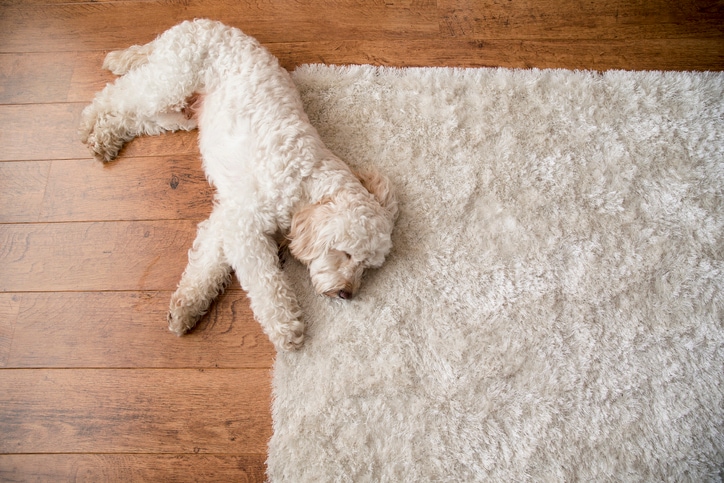By freelance writer Kelly Sundstrom
Most dogs shed hair, especially during the hot summer months, but a dog losing hair in massive amounts or with bald spots could mean something more serious such as allergies, hormonal imbalance, mites, trauma or infection. While it’s normal for most dogs to shed at some point throughout the year, if large clumps of dull hair or fur fall out easily or if your dog’s fur is thinning to the point where you can see her skin, this is a sign of excessive hair loss.
“There can be major underlying health problems going on, like organ issues,” explains Dr. Patrick McHale from Seneca Trail Animal Hospital, “or dog hair loss can be caused by hormonal problems.” If your dog is losing hair, there are several things you should consider.
“The most common causes are contact allergies, flea allergies and food allergies,” says McHale. In the case of allergies, the hair loss is caused by all the scratching the dog does.
Your dog could also be sensitive to specific seasonal allergens in the air, says Greg Martinez, a veterinarian with Gilroy Veterinary Hospital and the author of “Dog Dish Diet.” If your dog has hair loss only a few months out of the year, especially on her back and sides, this is called seasonal flank allopecia.”
Take a look at the causes of a dog losing hair and find out how to help your furry friend.
>> Searching for a dog sitter? Find one in your area now.
Canine hair loss causes
Mange
Mites responsible for mange can take over your dog’s fur and cause patchy hair loss. Mange causes skin scaliness that will make your dog itch excessively. This itching leads to hair loss if severe enough.
Trauma
Hair loss caused by trauma most often occurs as a result of a dog chronically licking their own fur. This condition, called acral lick dermatitis, damages the hair follicle and leads to hair loss. Trauma can also happen as a secondary reaction from an injury.
Allergies
Dogs can have allergies to certain foods, fleas and chemicals found in skin care products. Certain dog breeds are more susceptible to allergies, such as golden retrievers, bulldogs and Yorkshire terriers. Hair loss stemming from allergies leads to redness on the skin, itching, hot spots and bumps.
Infection
Different infections can cause dog hair loss, including ringworm, folliculitis and cancer. With infection-related hair loss, you might notice nodules with or without pus, scaling, redness and hot spots.
Hormonal imbalance
Many hormonal imbalances can lead to hair loss in dogs. Thyroid disorders, pituitary dwarfism and adrenal gland deficiency can all cause progressive hair loss.
Treatments for dog hair loss
Treatment for your dog’s hair loss will depend on the cause, so make sure to check with your vet before treating your pet!
Use antibiotics
Your veterinarian may prescribe antibiotics to treat any infections causing your dog to lose hair. Your vet may need to remove any associated nodules or tumors contributing to hair loss, and potentially treat your dog with antibiotics as well as other medications for the illness.
Change your dog’s diet
If your veterinarian thinks that your dog’s hair loss is caused by a food allergies, eliminate the food in question from his diet. The most common food allergies in dogs include wheat, corn, soy, eggs and even beef or chicken. Dr. Martinez also recommends talking to your vet about adding supplements to your dog’s food that can help regrow hair, such as melatonin.
Undergo a hormone treatment
If your dog has a hormone imbalance, supplements can stop further hair loss and may actually help your dog regrow hair. Vets can run tests to determine if hormone treatment will help the problem.
Use hydrocortisone shampoos and sprays
Treat excessive licking and soothe itchy skin by bathing your dog with a dog-specific shampoo that contains hydrocortisone. The hydrocortisone will calm irritated skin can promote speedy healing.
You can also use a hydrocortisone spray applied directly to specific itchy or hot spots. Avoid using human shampoos and hair products on your dog, since they often contain ingredients that can seriously irritate your dog’s skin.
*This article is for general informational purposes only. It is not intended nor implied to be providing medical advice and is not a substitute for such advice. The reader should always consult a health care provider concerning any medical condition or treatment plan. Neither Care.com nor the author assumes any responsibility or liability with respect to use of any information contained herein.
